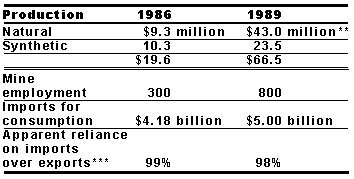
Since 1935, the mining of gemstones in the United States has been almost entirely a recreational activity of mineral collectors and hobbyists.
In recent years, very few individuals have derived their entire income from gemstones mined by themselves.
This is not to say that the proprietors of roadside rock shops buy all of their stock from others. Rock shops are abundant in areas of the United States that are rich in gem materials, and the shops tend to specialize in the local gem commodities, most of which the proprietors gather.
Rather than doing the mining themselves, owners of land that has a deposit of gem-quality minerals sometimes charge hobbyists for the right to collect gemstones. For example, diamond in Arkansas, opal in Idaho, and agate in Oregon and Washington are mined by hobbyists under this "fee digging" arrangement.
However, the flow of money into the local economy by paying these small fees and by the purchase of gemstones is minor compared to the money the enthusiasts spend for lodging and other living expenses while visiting an area to dig for gemstones.
Several kinds of natural gemstones have been found in every State of the United States, but much larger deposits of the most precious kinds are found outside the United States.
The 1990 U.S. output of natural gemstones was primarily from Tennessee, California, Arizona, Arkansas, Montana, Nevada, and Maine.
An estimated 80,000 visitors found a total of 315 carats of diamonds in the Crater of Diamonds State Park in Arkansas. There were sizeable yields of freshwater pearls in Tennessee, turquoise in Arizona and Nevada, tourmaline in Maine, and tourmaline, kunzite, and garnet in California.
U.S. production of commercial gems includes agate, beryl, freshwater pearl, garnet, jade, jasper, mother-of-pearl, opal, peridot, quartz, sapphire, tourmaline, and turquoise.
Gemstones: Value of U.S. production vs. imports, 1986 and 1989*

*Estimated.
**Including freshwater pearls, natural and cultured.
***Imports - exports + adjustments for Government and industry stock changes.
Source: Mineral Commodity Summaries, 1991, U.S. Bureau of Mines.
Except for the few gem diamonds found each year in Arkansas, U.S. diamond production is very low.
Yet exploration for diamonds continues in Alaska, Colorado, Michigan, Minnesota, Wisconsin, and Wyoming. A diamond mining project at the Crater of Diamonds State Park in Arkansas is still being evaluated by the State.

The Hope Diamond, India
Photograph courtesty of
The Smithsonian Institution
World diamond reserves are estimated to be about 300 million carats, including near-gem materials but not diamonds of abrasive quality.
Most of the reserves are in southern Africa, Siberia, and western Australia. It is difficult to estimate reserves because the value of a given deposit varies with the market for the gems.
This page is
URL:https://pubs.usgs.gov/gip/gemstones/production.html
Last modified 06-18-97 (jmw)


